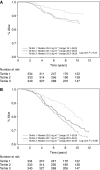Prospective study of predictors of vitamin D status and survival in patients with colorectal cancer
- PMID: 19690551
- PMCID: PMC2743349
- DOI: 10.1038/sj.bjc.6605262
Prospective study of predictors of vitamin D status and survival in patients with colorectal cancer
Erratum in
- Br J Cancer. 2010 Mar 16;102(6):1079
Abstract
Background: In an earlier study, a 25-hydroxyvitamin D(3) (25(OH)D) score calculated from known predictors of vitamin D status significantly predicted plasma levels of 25(OH)D and the risk of colorectal cancer, but the influence of the 25(OH)D score on survival after diagnosis is unknown.
Materials and methods: We prospectively examined the influence of post-diagnosis predicted 25(OH)D levels on mortality among 1017 participants in the Nurses' Health Study and Health Professionals Follow-Up Study who were diagnosed with colorectal cancer from 1986 to 2004. Colorectal cancer-specific and overall mortality according to quintiles of predicted 25(OH)D levels were assessed. Cox proportional hazards models were used to calculate hazard ratios (HRs) adjusted for other risk factors of survival.
Results: Higher predicted 25(OH)D levels were associated with a significant reduction in colorectal cancer-specific (P trend=0.02) and overall mortality (P trend=0.002). Compared with levels in the lowest quintile, participants with predicted 25(OH)D levels in the highest quintile had an adjusted HR of 0.50 (95% CI, 0.26-0.95) for cancer-specific mortality and 0.62 (95% CI, 0.42-0.93) for overall mortality.
Conclusion: Higher predicted 25(OH)D levels after a diagnosis of colorectal cancer may be associated with improved survival. Further study of the vitamin D pathway in colorectal cancer is warranted.
Figures


References
-
- Adams JS, Clemens TL, Parrish JA, Holick MF (1982) Vitamin-D synthesis and metabolism after ultraviolet irradiation of normal and vitamin-D-deficient subjects. N Engl J Med 306: 722–725 - PubMed
-
- Belanger CF, Hennekens CH, Rosner B, Speizer FE (1978) The nurses' health study. Am J Nurs 78: 1039–1040 - PubMed
-
- Braun MM, Helzlsouer KJ, Hollis BW, Comstock GW (1995) Colon cancer and serum vitamin D metabolite levels 10–17 years prior to diagnosis. Am J Epidemiol 142: 608–611 - PubMed
-
- Colditz GA, Manson JE, Hankinson SE (1997) The Nurses' Health Study: 20-year contribution to the understanding of health among women. J Womens Health 6: 49–62 - PubMed
-
- Deeb KK, Trump DL, Johnson CS (2007) Vitamin D signalling pathways in cancer: potential for anticancer therapeutics. Nat Rev Cancer 7: 684–700 - PubMed
Publication types
MeSH terms
Substances
Grants and funding
LinkOut - more resources
Full Text Sources
Medical

